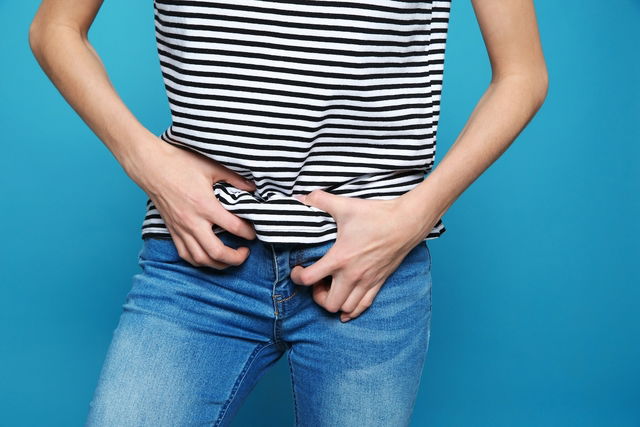An itchy groin mat be caused by hair regrowth following hair removal, or fabric irritation from underwear. In these cases, applying a moisturizing or hypoallergenic cream can help relieve itching and discomfort quickly.
Nonetheless, an itchy groin can also indicate a skin problem, like jock itch which is more common in men. This type of itching can also affect women and cause itching in both the groin and around the vagina. Groin itching can also occur due to pubic lice, which is a more rare condition.
It is important to consult your family doctor or a dermatologist if your itching does not improve within 3 days of hygiene measures, of using cotton-based underwear or applying moisturizers. Worsening or persistent symptoms should be assessed, and testing may be needed to rule out other causes of an itchy groin

1. Underwear irritation
Skin irritation, or contact dermatitis, is one of the main causes of male or female itching. There are many pieces of clothing that are made with synthetic materials, which can compromise airflow and lead to itching or irritation.
In addition to itching, this type of irritation can also causes symptoms like redness, skin peeling or the appearance of white or red blistered around the groin. This is caused by contact with a substance present in the fabric.
What to do: In these cases, you should apply a hypoallergenic moisturizer, wash your underwear before using it, and use cotton-based underwear. If itching does not improve with these measures after 3 days, you should see your doctor or dermatologist for assessment and to start appropriate treatment.
2. Jock itch
Jock itch is the main cause of an itchy groin in men. It is more common in men as they produce more sweat and have more hair than women, which makes them more susceptible to fungal growth in this area. In these cases, the area appeared reddened and itches. Skin can start to peel and red rashes with small blisters and lumps can appear. Read more about the symptoms and causes of jock itch.
What to do: To stop groin itching caused by a fungal skin infection, you should see your doctor for assessment and to recommend appropriate treatment. Jock itch can be treated with antifungal creams or ointments, however the doctor may prescribe oral antifungals for more severe cases.
3. Hair growth
Hair removal with a razer or wax can cause skin irritation around the groin, making it more senstive and itchy. Within a few days of hair growth, pores can become blocked and hairs can become ingrown, leading to an itchy groin.
What to do: To relieve an itchy groin caused by hair removal, you should apply a moisturizing cream to hydrate the skin and treat irritation from itching. This will help to reduce the urge to itch.
Other tips include exfoliating prior to hair removal, using shaving cream, and to use razers in the direction of hair growth.
4. Yeast infection
A yeast infection is the most common cause of groin itching in women, and is associated with symptoms like vaginal itching, pain or burning during sex, redness, vulvar swelling and a white discharge. Although it is most commonly seen in women, it can also affect men and cause symptoms like itching and itchy groin. Learn more about the causes of a vaginal yeast infection and how it presents.
What to do: To treat an itchy groin caused by yeast infections, you should see your doctor for assessment and treatment, which may be done with topical or oral antifungals. See our article about treatment of yeast infections to understand the different options available.
5. Pubic lice
Pubic lice are more frequent in people with inadequate hygiene or in people who share towels or underwear. It can affect both men and and women and cause redness, irritation and itchy groin.
What to do: To treat this type of itching, you should see your doctor for medication to treat the like, like ivermectin. Other tips include removing all genital or pubic hair, using tweezers to remove the lice and to wash all your bedsheets, underwear and pillows in water over 60ºC (or 140ºF)
